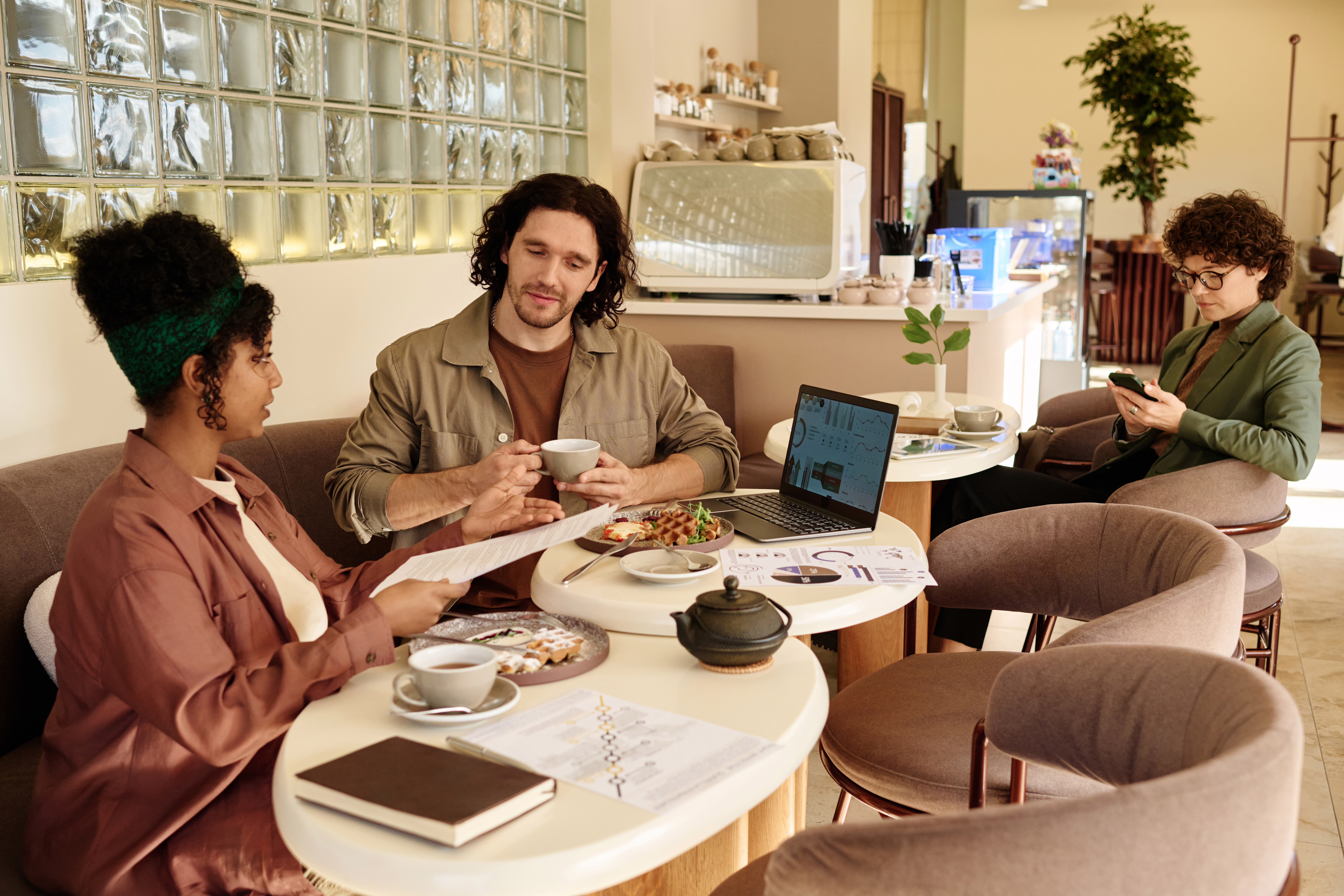Table of Contents
In 2025, remote work has become more common than ever, but with it comes a big challenge: How do you overcome isolation as a remote worker while staying social and connected?
Working from home offers freedom and flexibility, yet many experience remote work loneliness when day after day passes without in-person interaction. Surveys show that one in four fully remote employees reports feeling lonely “a lot” during the day. Even those who love the remote lifestyle sometimes find themselves battling work from home loneliness and craving a bit of office banter.
But the good news is that remote work isolation doesn’t have to be your new normal. With a bit of creativity and effort, you can maintain an active social life and thrive in your home office.
This blog will help you Stay Social as a Remote Worker in 2025 by exploring 10 practical strategies to beat the loneliness of working from home. From scheduling virtual coffee chats to leveraging coworking spaces, these tips are jotted down together to make you feel connected even if you’re living alone and working from home. Let’s dive in!
1. Establish a Daily Routine with Social Breaks

One of the simplest ways to overcome isolation is to add structure to your day that includes social time. It’s easy to roll out of bed and work in pajamas all day, only to realize you haven’t left the house or spoken to anyone. One in three remote workers admits their biggest struggle is that they stay home too often because they don’t have a reason to leave. This lack of a routine beyond work can fuel feelings of isolation.
To counter this, create a daily schedule that builds in short breaks for connection. Treat these social breaks as non-negotiable appointments with yourself. For example, you might plan to:
Take a real lunch break
Step away from your screen and, if possible, have lunch with a friend or family member. If no one is available in person, call someone for a quick chat while you eat. Workplace experts warn that skipping breaks can drain your “social battery,” so use that time to recharge with human interaction.
Go outside once a day
A simple walk to a coffee shop or around the block can work wonders. Maybe grab your morning coffee at a local café where you can exchange a few words with the barista or smile at a familiar face. Having a routine of getting out of the house ensures you don’t go for days in isolation.
Schedule after-work meetups
Give yourself something to look forward to after work. It could be a gym class, a book club, or dinner with a friend. Knowing you have social plans later can make the work-from-home day feel less isolating.
2. Schedule Virtual Coffee Chats and Watercooler Conversations

When you work remotely, you miss out on those spontaneous “watercooler” chats in the office hallway. To fill that gap, proactively schedule virtual coffee breaks or casual check-ins with your colleagues and friends. It might feel a bit awkward to put a chat on the calendar, but it’s a great way to ensure you and others make time to socialize.
Remember, you’re probably not the only one feeling a bit disconnected. In one survey, 24% of remote workers said they felt disconnected from their team. A simple invite like “Hey, want to grab a virtual coffee for 15 minutes on Friday?” can go a long way.
Use your company’s chat tools or video platforms to recreate social moments:
Virtual coffee/tea break
Pick a time once or twice a week to video call a coworker just to talk about non-work stuff over a cup of coffee. It’s the remote equivalent of bumping into someone in the break room. You can even invite a small group and keep it informal.
Slack or Teams channels for fun
Engage in your workplace’s casual chat channels (or start one!). Share a funny meme in the #random channel, talk about weekend plans, or discuss the latest episode of a popular show. These light-hearted interactions in group chats can mimic the camaraderie of an office.
“Donut” meetings
Some companies use apps like Donut that randomly pair employees for quick get-to-know-you chats. If your team has something like this, take advantage of it. If not, you can still play matchmaker and pair up team members (or other remote friends) for short intro calls to spark new connections.
Keep the tone casual and conversational, just as you would in person. The goal is to talk about anything except work: hobbies, pets, the funny thing your kid said this morning, or what you’re cooking for dinner.
These small interactions can significantly reduce loneliness working from home by reminding you that you’re part of a team (or friend circle), not an island. Over time, regular virtual coffees help build genuine friendships. When you log off a friendly chat, you’ll likely feel a morale boost knowing you had a laugh or meaningful exchange with someone that day.
3. Work from Coworking Spaces or Cafés Occasionally

In a coworking space, you’ll find you’re not alone in your remote journey. Being around others, even strangers, can ease the sense of isolation.
Sometimes, the best remedy for remote work isolation is a change of scenery. If you’ve been living in your home office, try taking your work to a coworking space, library, or café once in a while. Being in an environment with other people can instantly make you feel less isolated.
Studies have found that coworking can significantly reduce remote work loneliness. In one survey, 83% of people reported feeling less lonely as a result of joining a coworking space, and 89% even said they felt happier since they started coworking. Those are huge benefits that come just from working in the same space as others!
You don’t necessarily have to interact heavily if you’re shy; even the background buzz of a coffee shop or the occasional “hello” at a coworking hub can lift your spirits. Of course, if you do feel like socializing, coworking spaces are perfect for it. Many host community events, networking lunches, or happy hours for members.
You might end up meeting other freelancers or remote employees to chat with people who understand the remote lifestyle. Before you know it, you could be meeting “coworking friends” for lunch or collaborating on ideas, just like in a traditional office.
If a paid coworking membership isn’t in your budget, get creative. Public libraries often have quiet work areas (plus, librarians to chat with). Some cities now even have pop-up coworking events at cafes. For example, in Los Angeles, groups have organized coworking meetups in coffee shops to bring remote workers together. Keep an eye on community boards or apps like Meetup for remote worker gatherings in your area.
The key is to get out of the house and work among people now and then. You’ll likely find you’re more motivated and upbeat. As a bonus, changing your environment can spark creativity and break the monotony of the same four walls. Even one or two days a week outside your home office can make a big difference in overcoming that isolated feeling.
4. Plan Face-to-Face Meetups with Colleagues or Peers

Remote work doesn’t mean you never meet your coworkers or peers in person; you may just have to be intentional about making it happen. If you have colleagues who live in the same city or region, reach out to arrange an occasional meet-up. This could be as simple as two remote coworkers grabbing lunch or co-working from a coffee shop for an afternoon. Meeting face-to-face helps strengthen bonds that are usually maintained through screens. You’ll find that conversation flows more freely in person, and it builds trust and camaraderie that carry over to virtual work.
Many distributed companies also organize periodic team offsites or retreats. If your company offers an annual meetup, try your best to attend. Spending a few days with your team in person, whether for work sessions or fun activities, can massively improve how connected you feel to your coworkers afterward. Those inside jokes and memories from the retreat become fuel for long-distance friendship later. As a remote worker, you might initially feel nervous about meeting people you only know via Slack, but remember they’re likely excited (and a bit nervous) to meet you too. Embrace the opportunity to socialize in person; it’ll make collaboration smoother and more enjoyable when you’re back online.
Don’t have coworkers nearby? Consider meeting up with other remote workers or professionals in your industry. With so many people working remotely now, chances are there are others around you in the same boat. You can find local remote work meetups through sites like Meetup.com or LinkedIn local events. For example, there might be a monthly “remote worker coffee meetup” in your city where anyone who works from home comes to socialize and share tips. It’s a great way to make new friends who understand the remote work lifestyle. Even if you work in different fields, you’ll bond over common experiences (Zoom fatigue, anyone?).
Finally, don’t forget your existing network. If you travel to another city, see if any old friends or former colleagues are there and free to meet. Working remotely gives you the flexibility to blend work with travel, so you can occasionally work from a friend’s house or meet them after your workday. These face-to-face interactions, whether with colleagues or peers, rejuvenate your social skills and remind you that the world is bigger than your home office. Every handshake or hug with someone you’ve only seen in a tiny video square can make remote work feel far less remote.
5. Join Online Communities and Interest Groups

When your immediate work team is small or not very social, you can still find a community online. There are countless online groups where remote workers come together to chat, share advice, or just hang out virtually. Joining these communities can give you a sense of belonging beyond your company and help replace the office camaraderie you might miss.
For professional connections, consider joining Slack or Discord communities dedicated to remote workers. For example, there are Slack groups for developers, marketers, writers, and you name it, where a lot of members happen to be remote and swap stories and tips.
Some communities even host live virtual coworking sessions in a “virtual café” setting, where you log into a Zoom room and work silently alongside others, taking breaks to talk. It might sound odd, but it can make you feel like part of a group. If Slack isn’t your thing, forums and subreddits (like r/remoteWork or r/digitalnomad) are also great places to connect with fellow remote employees and discuss the ups and downs of this lifestyle.
Beyond work-specific groups, think about your interests and hobbies. The internet is full of communities for just about every interest. Love knitting, gaming, woodworking, or fitness? There are Facebook groups, Discord servers, and online clubs where you can meet people and geek out together. Interacting regularly in a casual interest-based group can fight loneliness too; it gives you people to talk to each day who share your passions. For instance, if you join an online book club, you’ll have weekly video chats about the book and life in general. These things can become real friendships over time, even if you live far apart.
The key is to be an active participant. Introduce yourself in new groups, contribute to discussions, and maybe attend virtual events or meetups they host. Over time, as you engage, you’ll start feeling that sense of community. You might find yourself saying, “Oh, my friend from the remote work Slack mentioned this issue too,” or getting quick advice by posting “Has anyone else felt stuck in a home-office rut?” and receiving supportive replies. Knowing that there are others out there who get it does wonders for reducing the feeling of isolation. Plus, these online friends could turn into real-life friends if you eventually meet up. Don’t be shy! Put yourself out there in a few communities and see what clicks. You’ll be reminded that even if you’re home alone, you’ve got a whole tribe online who has your back.
6. Pursue Hobbies and Activities Outside of Work

When work is done, don’t let your evenings blur into just more sitting at the computer or watching TV alone. One of the best antidotes to loneliness working from home is having a fulfilling life after you close your laptop. Pursue hobbies and activities that get you out of the house and interacting with others. This could be anything that genuinely interests you: joining a local sports league, taking a cooking or art class, volunteering in your community, or becoming a regular at a gym or yoga studio. The activity itself is fun and enriching, and the side effect is you’ll meet people naturally.
If you live alone and work from home, it’s especially important to be proactive about this. Maybe you schedule your week so that Monday is for a language class on Zoom (where you can chat with classmates), Wednesday you go to an in-person dance class, and Friday is dinner with friends. Find a balance that energizes you. These non-work social interactions give you something to look forward to and remind you that work isn’t everything. You’ll likely find that having a fun activity on the calendar keeps you motivated during work hours (“I have to finish by 6 to make it to my meetup!”), and it prevents that cabin fever feeling.
Hobbies also combat the mental health impacts of isolation. Loneliness isn’t just unpleasant; it can be harmful. It’s been said that chronic loneliness poses health risks as serious as smoking 15 cigarettes a day. Yikes! The U.S. Surgeon General even declared loneliness a public health epidemic recently. On the flip side, staying socially active can improve your well-being. Research shows that people with strong social ties tend to live longer and healthier lives than those without.
In a survey of remote workers, 76% said workplace loneliness negatively impacted their mental health. A clear sign that we need connections outside of just work. So, think of your hobby time as an investment in you.
Whether it’s walking a dog at the dog park (a great way to chat with fellow pet owners) or joining a casual weekly meetup (board game night, anyone?), do something that regularly brings you in contact with people. Not every acquaintance will turn into a close friend, but over time you might build a circle of local friends or at least friendly faces you see often. These activities will help fill your social cup so that even if your workdays are solo, your life isn’t. Plus, having interests outside of work makes you more interesting to talk to during work interactions as well, so it’s a win-win.
7. Find an Accountability Partner or Remote “Buddy.”

Sometimes, what you need is one go-to person you can regularly connect with during the workday, an accountability partner or “remote work buddy.” This is someone with whom you agree to check in regularly, share progress, or even co-work virtually. The idea is that you’re keeping each other company and motivated at the same time. Many remote workers find this arrangement incredibly helpful for both productivity and loneliness.
Your remote buddy could be a coworker or just a friend who also works from home. You might start the day by messaging each other your top goals, then check in at day’s end to report what you accomplished. Or you could set up a daily 10-minute video call in the morning to chat over coffee, almost like meeting by the watercooler, to start the day on a social note.
Another approach is to have a video call where you both work quietly for an hour or two, You’ll be amazed how simply seeing someone else concentrating in a little box on your screen can make you feel less alone and more focused.
Don’t limit it to just work talk, either. A remote buddy can turn into a real friend you vent to (“I can’t believe how long that Zoom meeting was!”) or celebrate wins with (“Finished my project! Time for a victory coffee.”). Having someone to share the little daily experiences with makes remote work feel less isolated.
It recreates the dynamic of leaning over to a coworker’s desk to sigh or laugh about something. So find your person, and you’ll keep each other sane, social, and maybe even more accountable to log off on time!
8. Take Advantage of Remote Work’s Flexibility to Socialize

One major perk of remote work is flexibility. Remember, remote work is a luxury that often lets you design your schedule. To combat loneliness, use that flexibility to your advantage. Instead of chaining yourself to your desk from 9 to 5 straight, permit yourself to integrate social activities into your day.
As long as you get your work done, it’s okay (and beneficial) to step away for human interaction. In a traditional office, you might chat with coworkers or go out for lunch; as a remote worker, you have the freedom to create those moments for yourself in different ways.
For instance, you could start your day a bit earlier so you can take a mid-morning break at 10 am to walk with a neighbor or have a video call with a friend in another time zone. Or if the weather’s nice, maybe you can wrap up work an hour early and meet a friend in the evening, then catch up on a bit of work later at night.
Many remote jobs allow this kind of flexibility in 2025, and it’s one of the top benefits people cite for loving remote work. (One study found flexibility in how to spend time was the #1 benefit for 22% of remote workers). So go ahead and enjoy that luxury by fitting in social time.
Think about it: The hours you used to spend commuting can now be spent being social. Instead of sitting in traffic, you could be at a morning fitness class saying hi to your workout buddies. Instead of a rushed lunch at your desk, you can have a relaxing lunch date with your partner or a friend.
Use calendar planning to block out these times if you have to. For example, mark 12:30 pm – 1:30 pm as “lunch break” so coworkers know you’re away. If you worry about how it looks, remember that as long as you’re meeting your responsibilities, most managers are fine with you taking breaks. Smart employers know a happy, socially fulfilled employee is likely more productive overall.
Also, communicate your availability with those around you. Let friends or family know when you have free pockets of time during the day. “I work from home, so I can pick the kids up from school and chat with the other parents,” or “I have Wednesdays free at 4 pm if you ever want to grab coffee.” You might be surprised how others will gladly accommodate. They might be working flexibly too, or happy to meet after their office hours.
By proactively scheduling social activities during the day, you ensure you don’t go the whole day without talking to anyone. The flexibility of remote work truly is a luxury, so use it to maintain your social connections and prevent burnout. You’ll likely find yourself returning to your tasks with a clearer, happier mind after taking time to connect with the world outside your home.
9. Communicate and Seek Support When You Feel Lonely

It’s important to remember that you don’t have to struggle in silence. If you’re feeling consistently isolated or down, communicate that to someone who can support you. This might mean talking to your manager or HR about how you’re feeling, especially if it’s affecting your work. Companies are increasingly aware that remote work isolation is a real issue. Absenteeism due to stress and loneliness costs U.S. employers an estimated $154 billion a year. So many employers want to help!
A good manager might offer solutions if they know you’re struggling, such as scheduling more team video meetings for social connection, pairing you with a mentor, or even helping fund a coworking space membership as part of wellness benefits. But they won’t know you’re feeling lonely unless you speak up. A simple, honest conversation like, “I love working from home, but I’ve been feeling a bit isolated lately,” can open the door to support.
Beyond your employer, let friends and family know that remote work can be lonely at times. Sometimes, those who haven’t experienced it don’t realize you might welcome more interaction. You could tell close friends, “Hey, since I work from home now, I’d love if we could chat on the phone occasionally during the week,” or ask a sibling to drop by for lunch if they’re nearby. People who care about you will be glad to include you once they understand that need. There’s no shame in saying, “I’m feeling a bit alone. I want to hang out.” You might find they’ve been feeling something similar!
Lastly, consider seeking out professional support if needed. Remote work loneliness can sometimes lead to anxiety or depression, and speaking with a therapist or counselor can help you navigate those feelings. There are many teletherapy options available (ironic, getting therapy via the same computer that sometimes makes you lonely, but it works!).
A therapist can provide coping strategies and be a sympathetic ear. Additionally, some online support groups or communities specifically focus on remote workers’ well-being. Joining a group chat or group video call with others who are working through the same challenge can be very validating. You’ll quickly learn your feelings are common and nothing to be embarrassed about.
10. Embrace New Social Technologies and the Future of Remote Work

The future of remote work is likely to bring new and better ways to stay socially connected, so keep an open mind and be willing to try new tools and approaches. We’ve come a long way from simple conference calls.
In 2025, more companies are experimenting with technologies like virtual reality meetups, “metaverse” office spaces, and interactive team-building platforms. While VR headsets aren’t standard issue (yet!), Some remote teams hold meetings or casual hangouts in virtual spaces where it feels like you’re in the same room. It might seem gimmicky, but many people find that seeing a 3D avatar of a colleague in a virtual coffee shop and having a conversation feels more real and engaging than a grid of muted webcams.
As these technologies improve, they could become a normal part of remote socializing. If your company offers an optional VR social hour or an online game night, give it a shot! You might be pleasantly surprised at how fun and bonding it is.
Apart from technology, there’s a growing movement to create structured opportunities for remote workers to gather. We mentioned pop-up coworking events (like those in LA) as a creative solution. We’re also seeing more communities and startups focused on remote workers’ social lives, from apps that help you find other remote workers nearby for lunch to co-living spaces where remote professionals live and work together for weeks at a time.
The idea is to blend the flexibility of remote work with the community of office life. Keep an eye out for these trends and see if any appeal to you. For example, if there’s a remote work conference or retreat happening (many exist now where people come together to work and play for a week), consider joining to meet your peers in person and learn new ideas for staying connected.
Final Thoughts
As a remote worker, embrace these changes. Be willing to try a new app your team introduces for informal chatting or participate in that experimental virtual team-building exercise. If your company hasn’t explored these, you can even suggest piloting something like a virtual break room or an online multiplayer game session as a team activity.
The worst that happens is it’s awkward, and you laugh it off; the best is that you discover a fantastic new way to bond. By staying proactive and open-minded, you can be at the forefront of making remote work more social. After all, remote work truly can be a luxury that offers the best of both worlds – the comfort of home and the connections of a community as long as we all continue to find innovative ways to bridge the distance.
Subscribe to WhatWorksNext today and join a community dedicated to transforming the way we work. Working smarter starts here!


